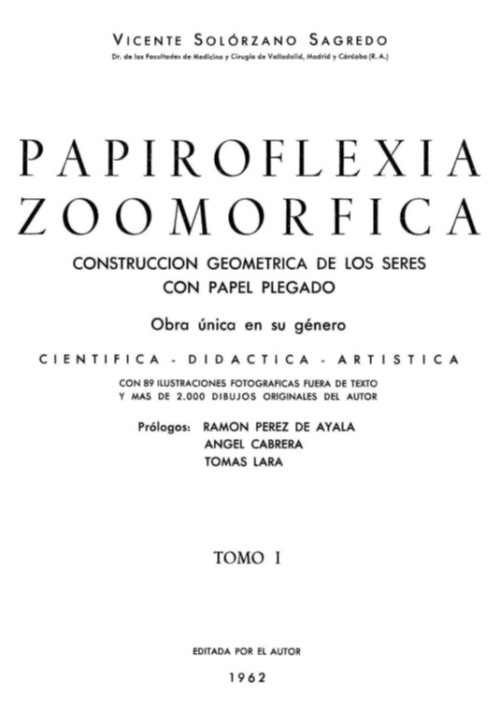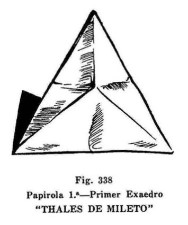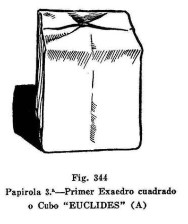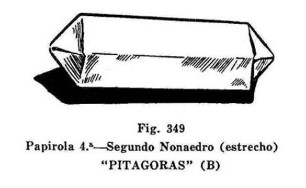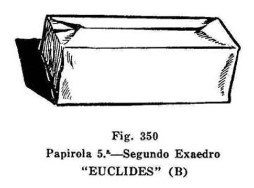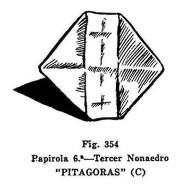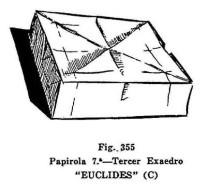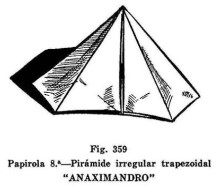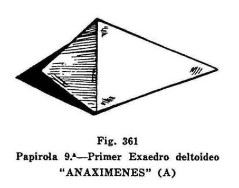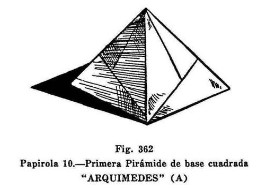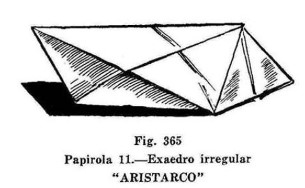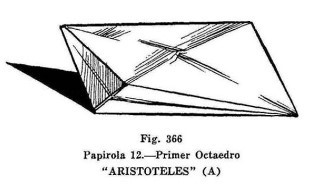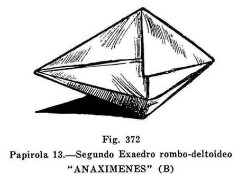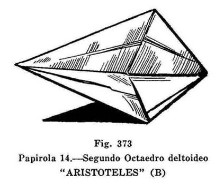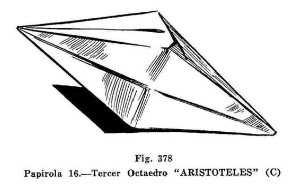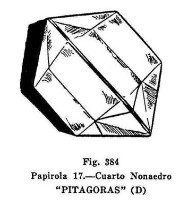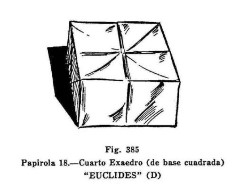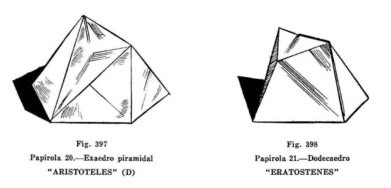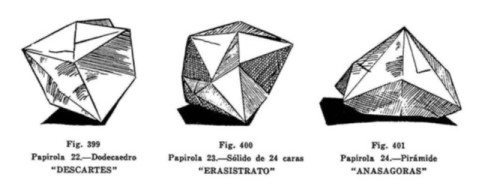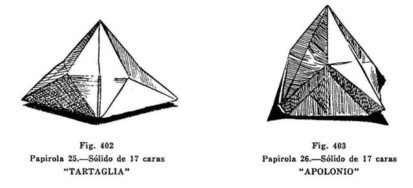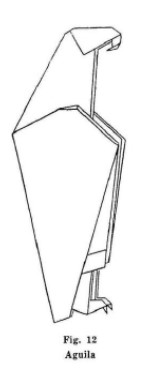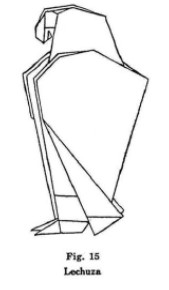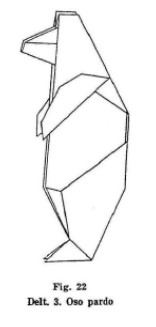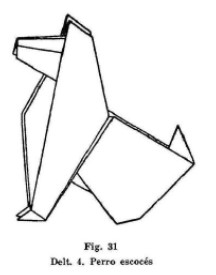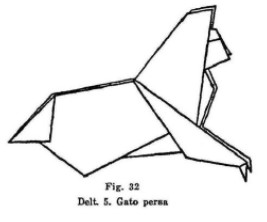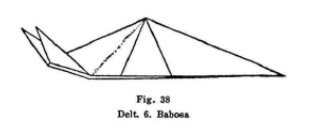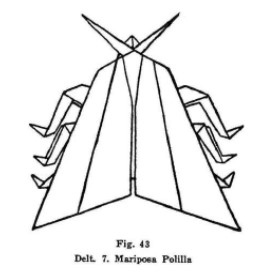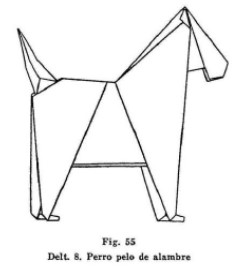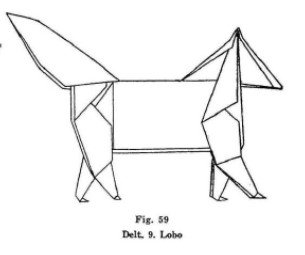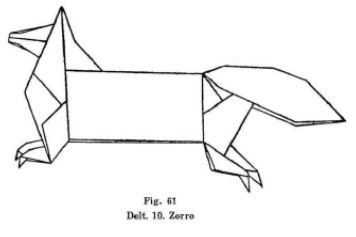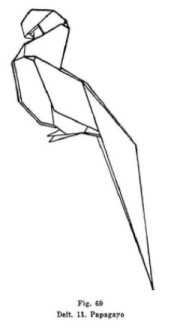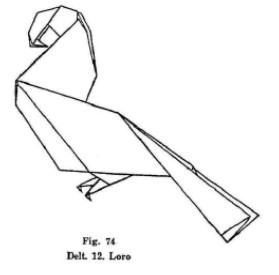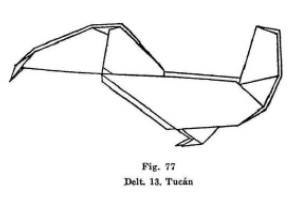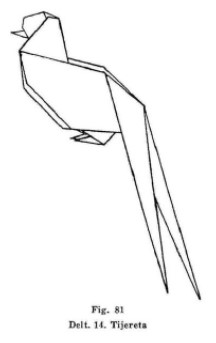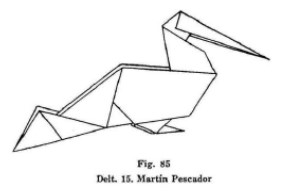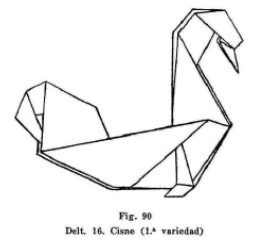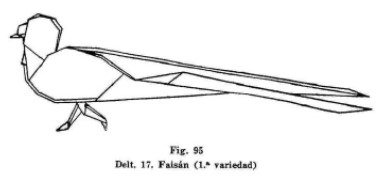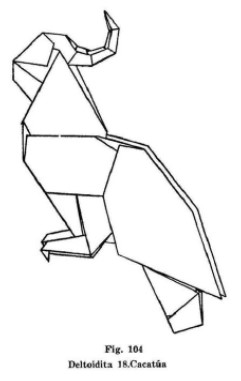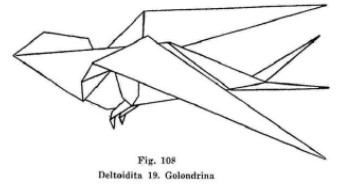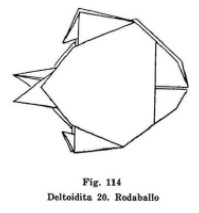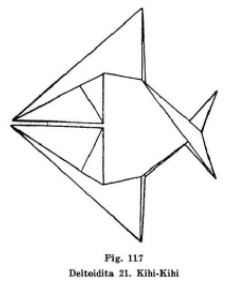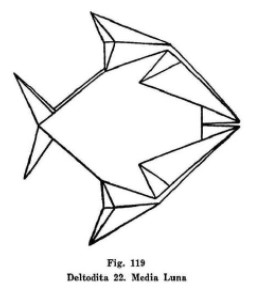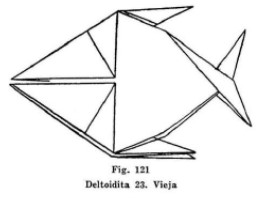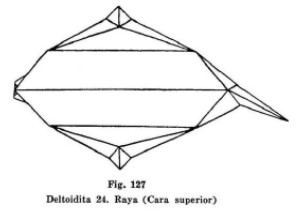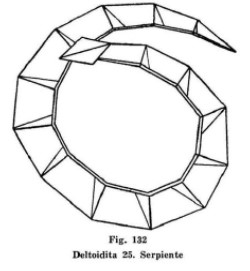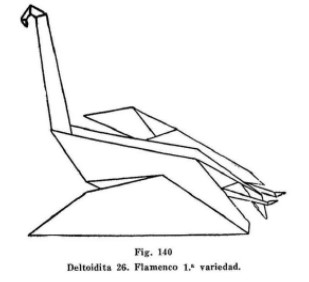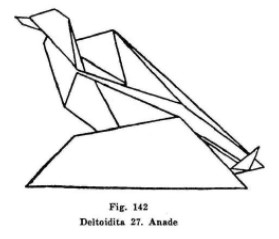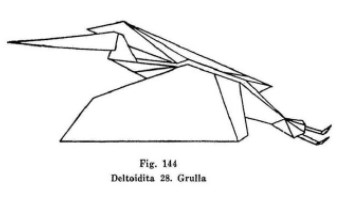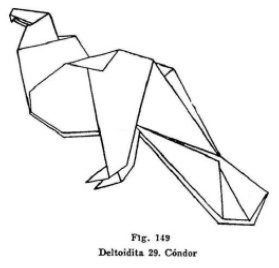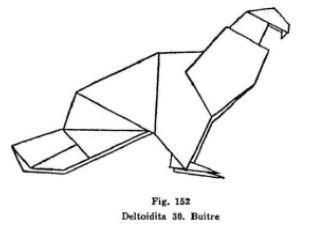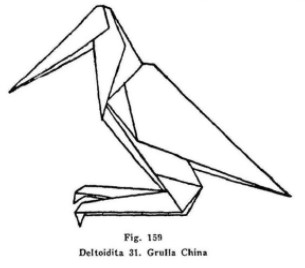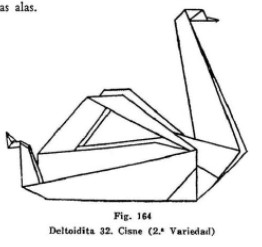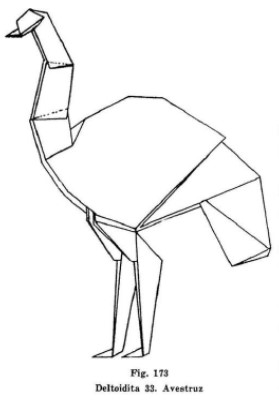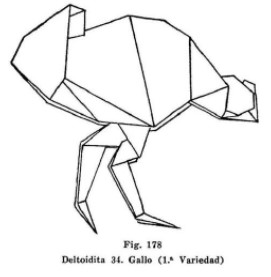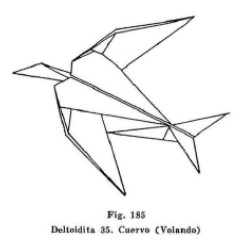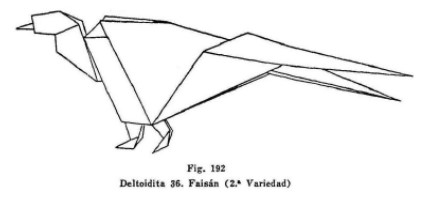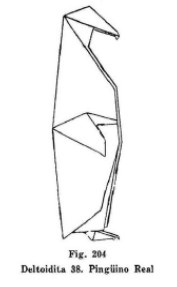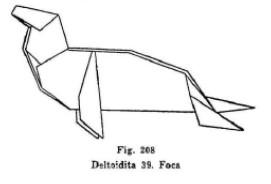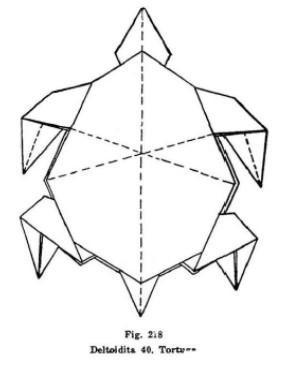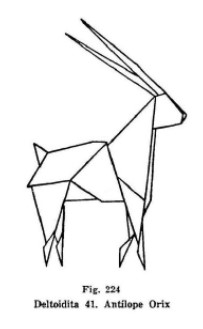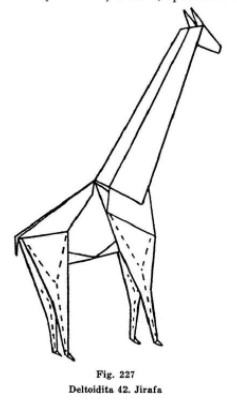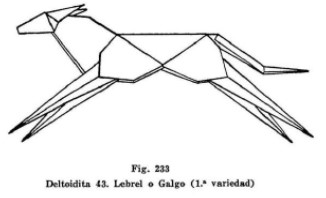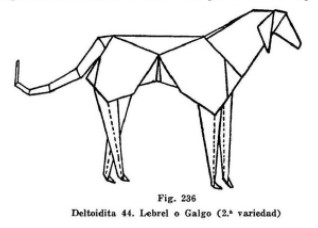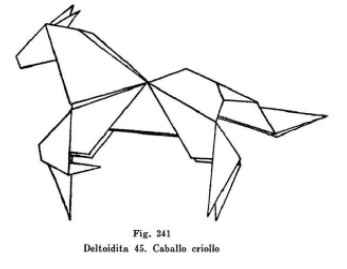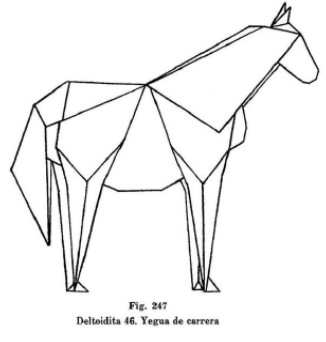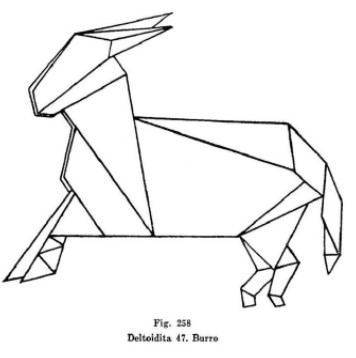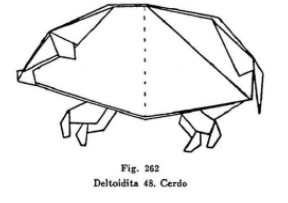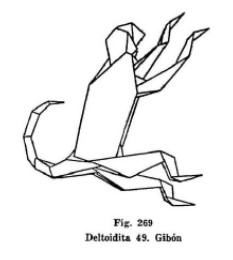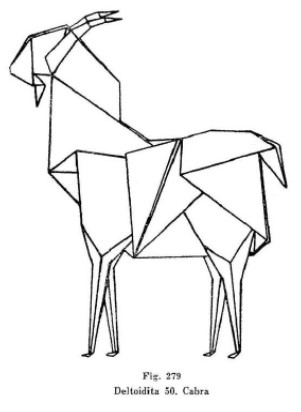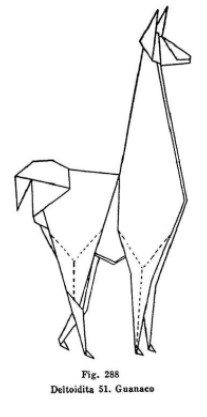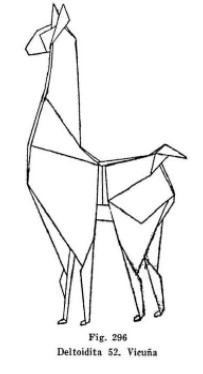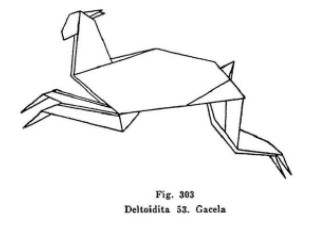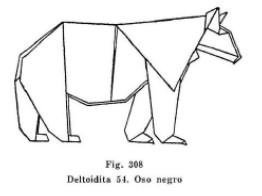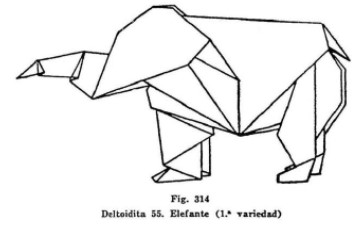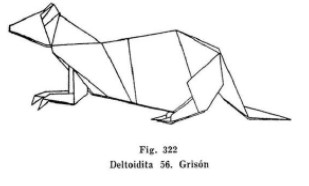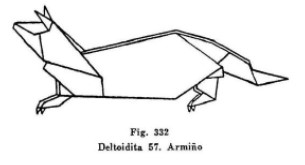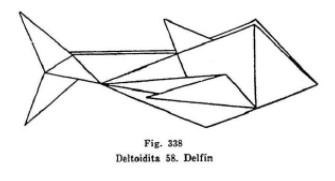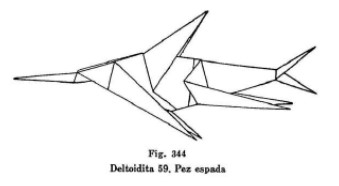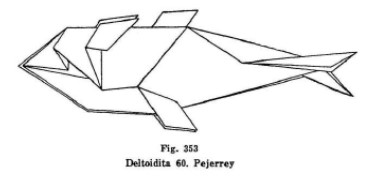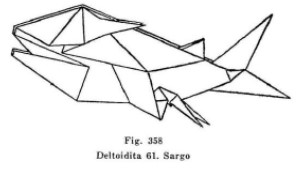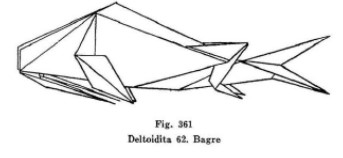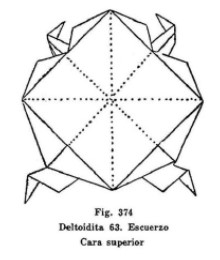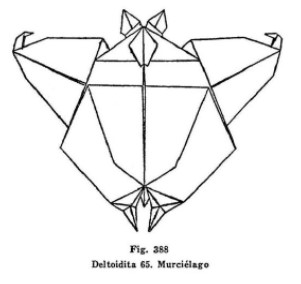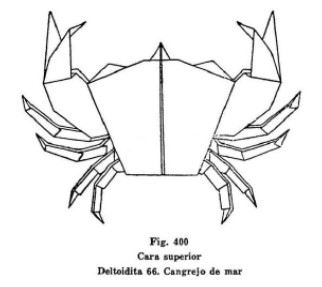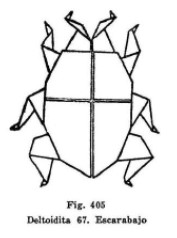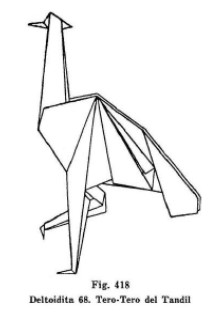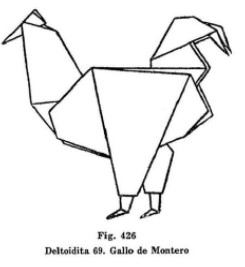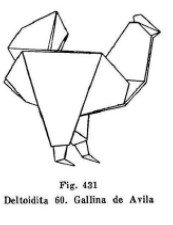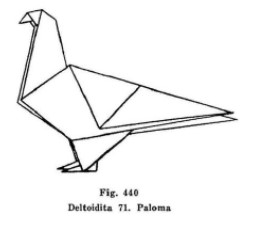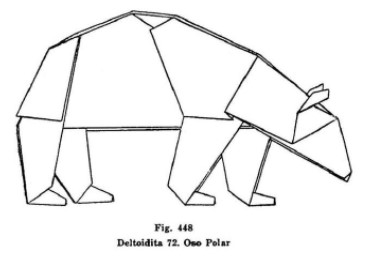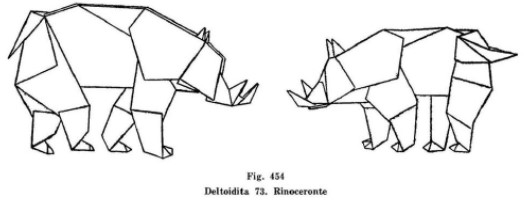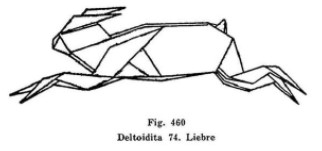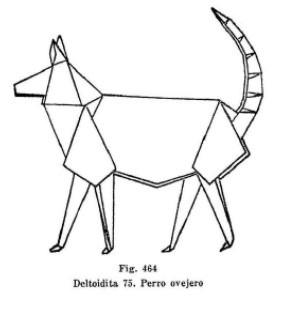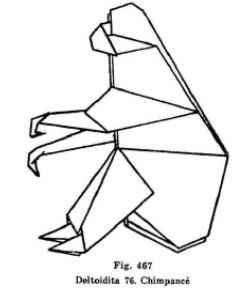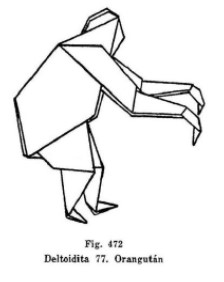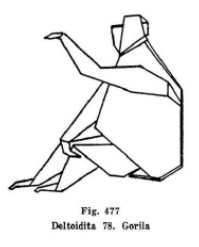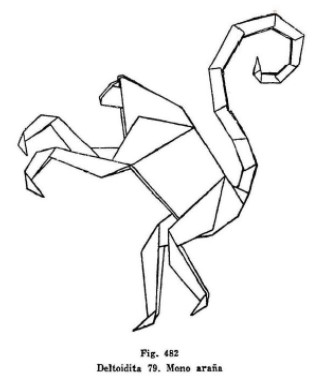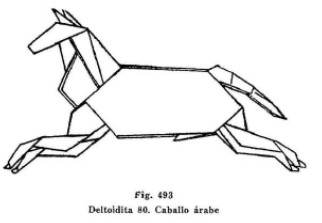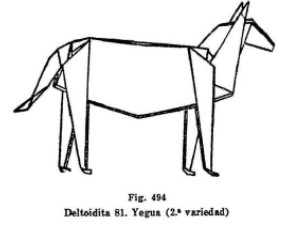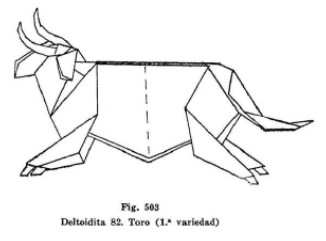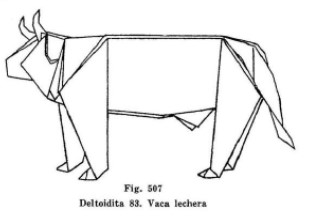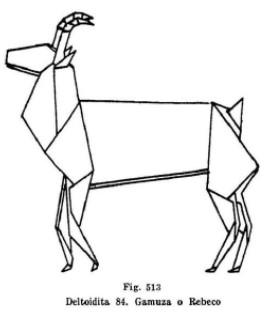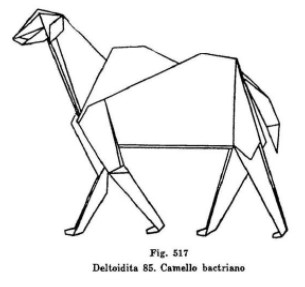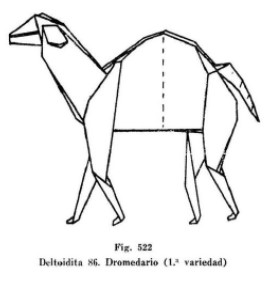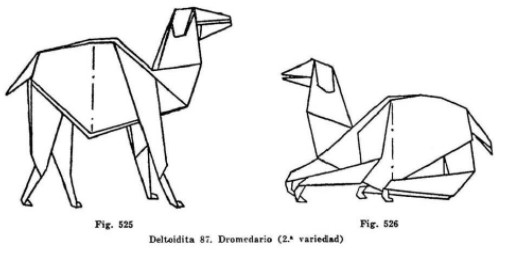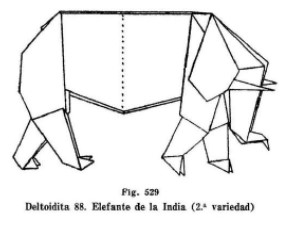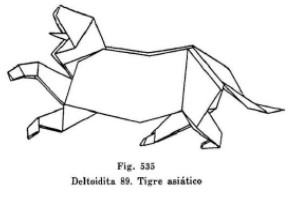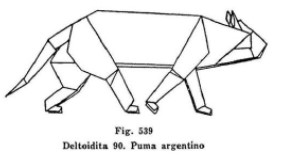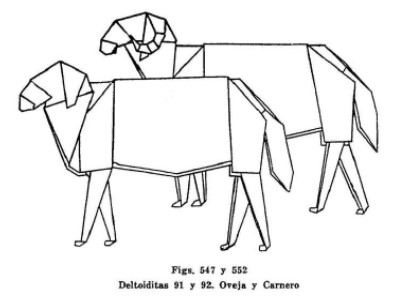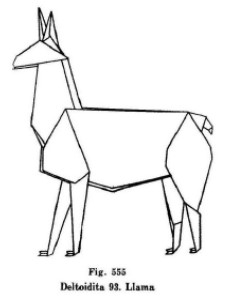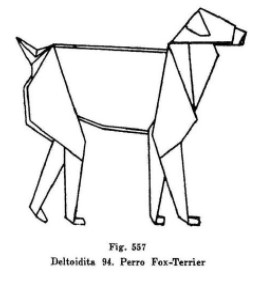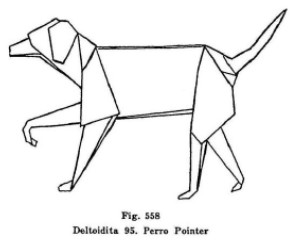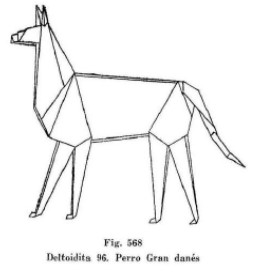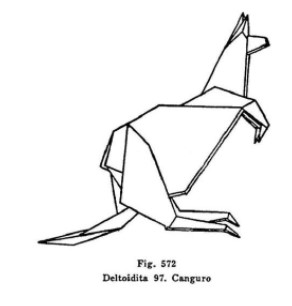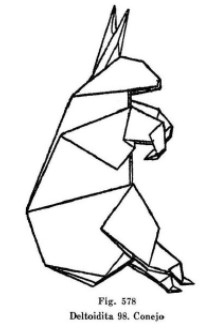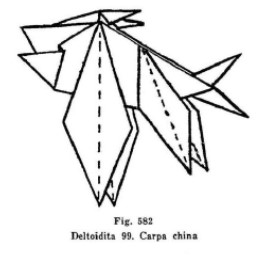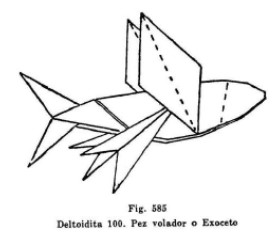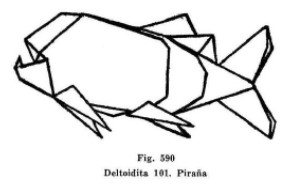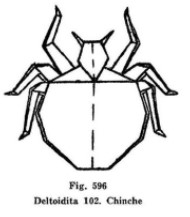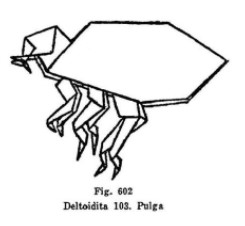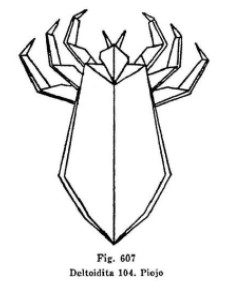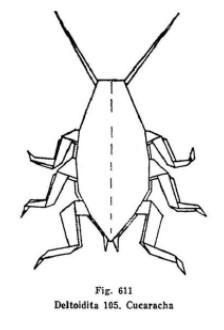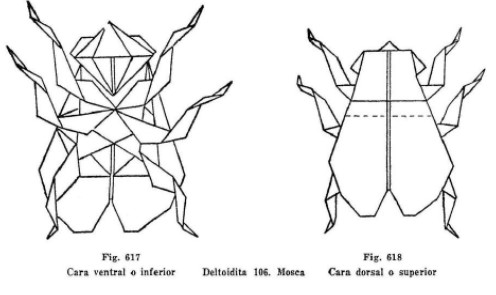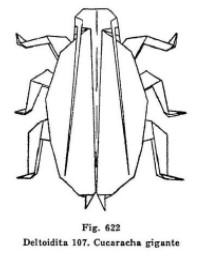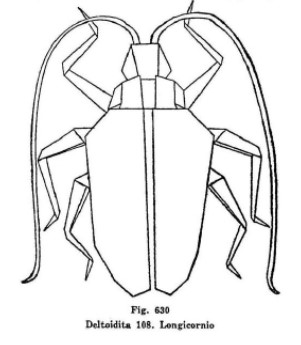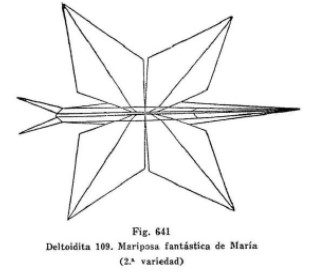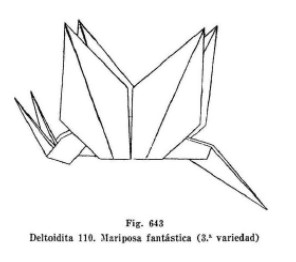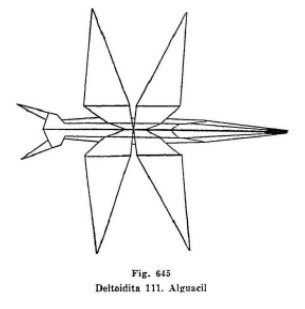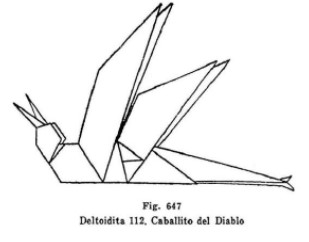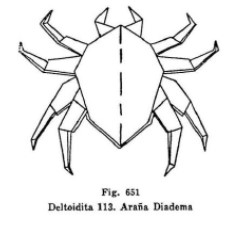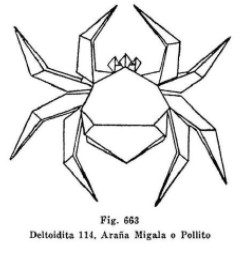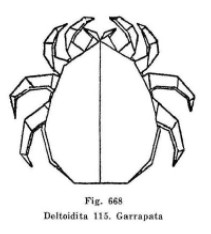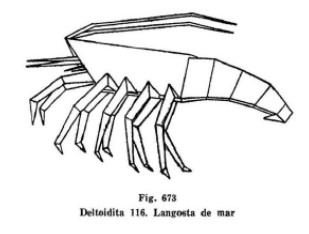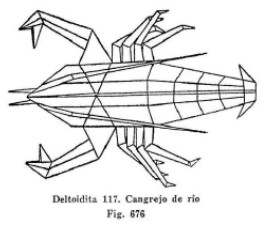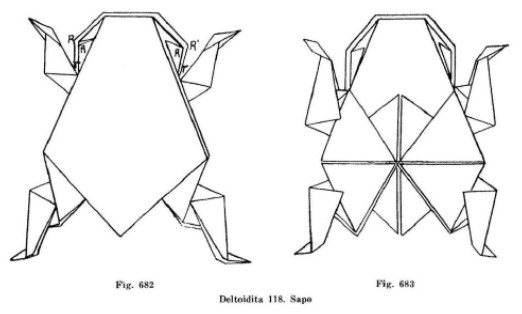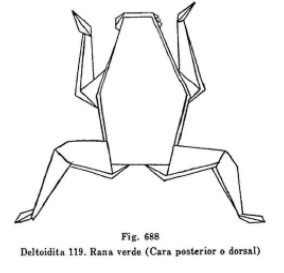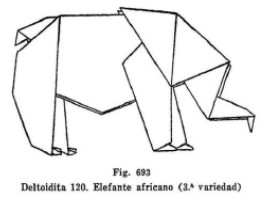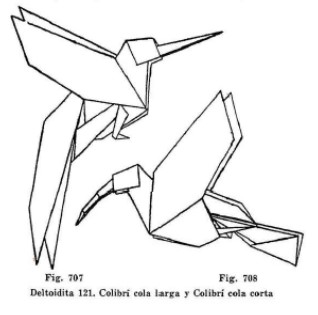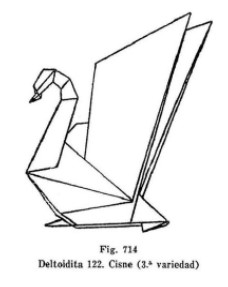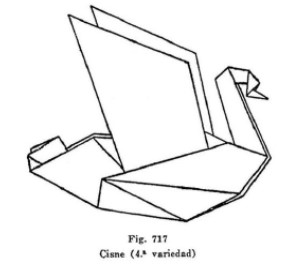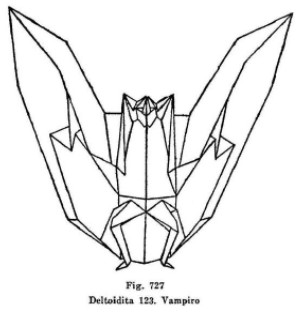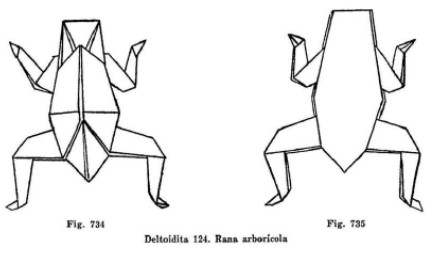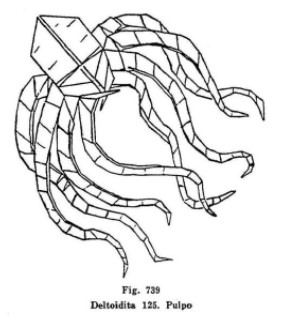| The Public Paperfolding History Project
x |
|||||||
| Papiroflexia Zoomorphica, Volume 1, by Vicente Solorzano Sagredo, 1962 | |||||||
'Papiroflexia Zoomorphica', Volume 1, was self-published by Vicente Solorzano Sagredo in 1962. Details of the contents of the second volume can be found here.
********** General Introduction These two volumes provide a detailed analysis of Dr Solorzano's system of 'deltoides' (bases) and provide diagrams for designs derived from them. In most cases the designs are derived by using cuts to create extra points. In some cases cuts are also used to create finishing details eg to create ears or antennae. Cuts are a fundamental part of Dr Solorzano's creative method, and only his simplest designs (if they are indeed his - see below) are made without them. Cuts do, however, enable Dr Solorzano to achieve designs such as spiders, lobsters etc which would otherwise have been impossible to achieve at the time. When these volumes were published Dr Solorzano was 75, and they can therefore be seen as a record of his lifetime's work in paperfolding design and as an attempt to secure his legacy. It does not appear, however, that his creative technique had significantly advanced since his designs were first photographed in the 1930s. The title pages (see above) state that the works contain 'more than 2000 original drawings by the author'. However, a profile of Ligia Montoya, written by Gershon Legman, in Vol 8: Issues 1 and 2 of 'The Origamian' for Spring and Summer 1968, claimed that these illustrations were drawn by Ligia Montoya. Legman also claimed that Solorzano had included some of Ligia Montoya's own designs for birds (though which ones are not specified), some of Legman's own designs, and those of unnamed others, in the book, without acknowledging their authorship. Solorzano subsequently disputed (at least parts of) this claim. Full details of the article and subsequent correspondence in the pages of 'The Origamian' can be found here. The designs in this volume for which Legman claimed authorship were 'Perro Pelo de Alambre' (Wire Haired Terier), 'Lobo' (Wolf) and 'Zorro' (Fox). Even with diagrams the methods used to create some of the designs are not entirely clear. Helpfully, however, there is a detailed analysis of the folding sequences of the single-sheet animal, bird and insect designs in this volume in 'Papiroflexia Zoomorphica de Dr Solorzano' by Teodosio de la Fuente, which was published by the Asociation Espanola Papiroflexia (AEP) in 1989. ********** Introduction to Volume 1 The work consists of: An Introduction by the author. A Prologue by Ramon Perez de Ayala, reprinted from articles titled 'Las pajaritas de papel de los dioses' in 'La Prensa' of Buenos Aires of 21st January 1945 and 'ABC' of Madrid of 16th August 1956. A Preface by Angel Cabrera. Part 1: Papiroflexia y Papirolas Papirological: A detailed analysis of those of Dr Solorzano's system of 'deltoides' (bases) derived from the square. Part 2: Papiroflexia Geometrica: Diagrams for geometrical solids folded from squares. Part 3: Realizaciones Papiroflexicas Zoomorphicas: Diagrams for various living creatures folded from squares. 125 designs of which 88 are cut. An Index of Neologisms used in the work. A general index to the work. ********** Analysis Geometrical Designs There are two series of these designs. Series 1 are inflatable designs, which are fundamentally variations of the Waterbomb design. Series 2 are derived from other of Dr Solorzano's system of bases. 'Euclides' is of course the Waterbomb, although this is not acknowledged in the text. Series 1
********** Series 2
********** Living Creatures folded from squares Aguila (Eagle)
********** Lechuza (Owl)
********** (Cut) Oso Pardo (Grizzly Bear)
********** Perro Escoces (Scotty Dog)
********** Gato Persa (Persian Cat)
********** Babosa (Slug)
********** (Cut) Mariposa Polilla (Butterfly Moth)
********** Perro Pelo de Alambre (Wire Haired Terier) (Note that Gershon Legman claimed that this was his original design not Solorzano's)
********** Lobo (Wolf) (Note that Gershon Legman claimed that this was his original design not Solorzano's)
********** (Note that Gershon Legman claimed that this was his original design not Solorzano's) Zorro (Fox)
********** Papagayo (Parrot)
********** Loro (Parrot)
********** Tucan (Toucan)
********** (Cut) Tijetera (Fork-tailed Flycatcher) A cut is used to form the forked tail
********** Martin Pescador (Kingfisher)
********** Cisne (Swan)
********** (Cut) Faisan (Pheasant)
********** Cacatua (Cockatoo)
********** (Cut) Golondrina (Swallow) A cut is used to create the forked tail
********** Rodaballo (Turbot)
********** Kihi-kihi
********** Media Luna (Half Moon)
********** Vieja (Old)
********** Raya
********** Serpiente (Snake)
********** (Cut) Flamenco (Flamingo)
********** Anade (Duck)
********** (Cut) Grulla (Crane) A cut is used to separate the legs
********** Condor
********** Buitre (Vulture)
********** Grilla China (Chinese Crane)
********** Cisne (Swan)
********** Avestruz (Ostrich)
********** Gallo de Rina (Fighting Cock)
********** (Cut) Cuervo Volando (Flying Crow) A cut is used to form the forked tail
********** (Cut) Faisan (Pheasant) A cut is used to separate the two parts of the tail
********** (Cut) Ciguena (Stork) A cut is used to separate the wings ********** (Cut) Pinguino Real (Royal Penguin) A cut is used to separate the wings
********** (Cut) Foca (Seal) A cut is used to separate the back legs
********** (Cut) Tortuga (Turtle) Cuts are used to create the front legs
********** (Cut) Antilope Orix (Oryx) Cuts are used to separate the back legs and the horns
********** (Cut) Jirafa (Giraffe) Cuts are used to separate the back legs and the horns
********** (Cut) Lebrel o Galgo (Greyhound) Cuts are used to create the legs and separate the ears
********** (Cut) Lebrel o Galgo 2 (Greyhound) Cuts are used to create the legs and separate the ears
********** (Cut) Cabalo Criollo (Wild Horse) Cuts are used to create the legs and ears
********** (Cut) Yegua de Carrera (Racing Mare) Cuts are used to create the legs and ears
********** (Cut) Burro (Donkey) Cuts are used to separate the front legs and the ears
********** (Cut) Cerdo (Pig) Cuts are used to create the legs
********** (Cut) Gibon (Gibbon) Cuts are used to create the arms and legs
********** (Cut) Cabra (Goat) Cuts are used to create the legs and the horns
********** (Cut) Guanaco Cuts are used to create the legs and the ears
********** (Cut) Vicuna Cuts are used to create the legs and the ears
********** (Cut) Gacela (Gazelle) Cuts are used to separate the hind legs and to create the ears
********** (Cut) Oso Negro (Black Bear) Cuts are used to separate the back legs
********** (Cut) Elephante (Elephant) Cuts are used to separate the back legs
********** (Cut) Grison o Huron (Ferret) Cuts are used to separate both pairs of legs
********** (Cut) Armino (Ermine) Cuts are used to separate both pairs of legs and the ears
********** (Cut) Delphin (Dolphin) A cut is used to separate the two parts of the tail
********** (Cut) Narval o Pez Espada (Narwhal or Swordfish) Cuts are used to create the fins and separate the two parts of the tail
********** (Cut) Pejerrey (Silverside) Cuts are used to create the fins and separate the two parts of the tail
********** (Cut) Sargo Cuts are used to create the fins and separate the two parts of the tail
********** (Cut) Bagre (Catfish) Cuts are used to create the whiskers and fins and to separate the two parts of the tail
********** Escuerzo (Horned Frog)
********** Caracol (Snail)
********** (Cut) Murcielago (Bat) A cut is used to create the ears
********** (Cut) Cangrejo de Mar o Cambaro (Crab) Cuts are used to create the legs and the pincers
********** (Cut) Escarabajo (Beetle) Cuts are used to create the legs and the antennae
********** (Cut) Tero-tero del Tandil A cut is used to create the crest
********** Gallo do Montero (Montero Rooster)
********** Gallina de Avila (Avila Hen)
********** Paloma (Dove)
********** (Cut) Oso Polar (Polar Bear) Cuts are used to create the backlegs and the ears
********** (Cut) Rinocerente (Rhinocerous) Cuts are used to create the back legs and the details of the head
********** (Cut) Liebre (Hare) Cuts are used to create the ears
********** (Cut) Perro Ovejero (Sheepdog) Cuts are used to create the front legs and the ears
********** (Cut) Chimpance (Chimpanzee) Cuts are used to create the arms
********** (Cut) Orangutan Cuts are used to help create the detail of the head
********** (Cut) Gorila (Gorilla) Cuts are used to help create the detail of the head
********** (Cut) Mono Arana (Spider Monkey) Cuts are used to create the back legs and the tail
********** (Cut) Caballo Arabe (Arab Horse) Cuts are used to create the front legs and ears
********** (Cut) Yegua (Horse) Cuts are used to create the front legs and ears
********** (Cut) Toro Espanol de Lidia (Spanish Fighting Bull) Cuts are used to create the front legs and the horns
********** (Cut) Vaca Lechera (Milk Cow) Cuts are used to create the front legs, horns and teats
********** (Cut) Gamuza o Rebeco (Chamois) Cuts are used to create the front legs and the horns
********** (Cut) Camello Bactriano (Bactrian Camel) Cuts are used gto create the front legs and the details of the head
********** (Cut) Dromedario (Dromedary)
********** (Cut) Dromedario 2 (Dromedary)
********** (Cut) Elephante de la India (Indian Elephant)
********** (Cut) Tigra Asiatico (Tiger)
********** (Cut) Puma Argentino
********** (Cut) Oveja (Sheep) in front and (Cut) Carnero Merino (Merino Ram) behind
********** (Cut) Llama
********** (Cut) Perro Fox-Terrier
********** (Cut) Perro Pointer
********** (Cut) Perro Gran Danes (Great Dane)
********** (Cut) Canguro (Kangaroo)
********** (Cut) Conejo (Rabbit)
********** (Cut) Carpa China (Chinese Carp)
********** (Cut) Pez Volador o Exoceto (Flying Fish)
********** (Cut) Pirana
********** (Cut) Chinche (Bug)
********** (Cut) Pulga (Flea)
********** (Cut) Piojo (Louse)
********** (Cut) Cucuracha (Cockroach)
********** (Cut) Mosca (Fly)
********** (Cut) Cucuracha Gigante (Giant Cockroach)
********** (Cut) Longicornio
********** (Cut) Mariposa Fantastica fe Maria (Butterlly)
********** (Cut) Mariposa Fantastica 2 (Butterfly)
********** (Cut) Alguacil
********** (Cut) Caballito del Diablo (Damselfly)
********** (Cut) Arana Diadema (Spider)
********** (Cut) Arana Migalao Pollito (Spider)
********** (Cut) Garrapata (Tick)
********** (Cut) Langosta de Mar (Lobster)
********** (Cut) Cangrejo de Rio (Crayfish)
********** Sapo (Toad)
********** Rana Verde Saltarina (Green Jumping Frog)
********** (Cut) Elephant Africano (African Elephant)
********** Top - (Cut) Colibri (Hummingbird) Bottom - version without cuts
********** Cisne (Swan)
********** Cisne (Swan)
********** (Cut) Vampiro (Vampire Bat)
********** Rana Arboricola (Tree Frog)
********** (Cut) Pulpo (Octopus)
********** |
|||||||
